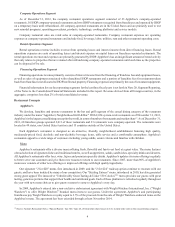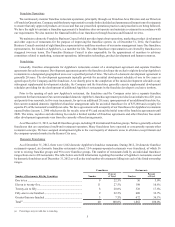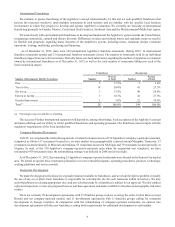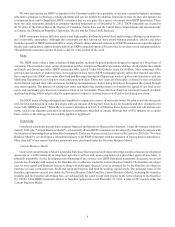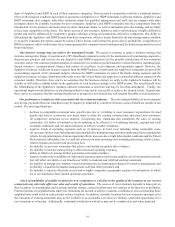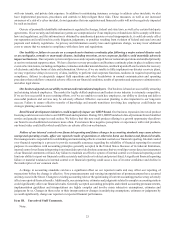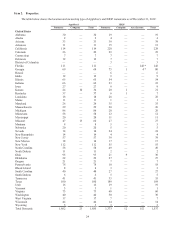IHOP 2012 Annual Report Download - page 32
Download and view the complete annual report
Please find page 32 of the 2012 IHOP annual report below. You can navigate through the pages in the report by either clicking on the pages listed below, or by using the keyword search tool below to find specific information within the annual report.14
requirements to provide information about the nutritional content of our food, may result in increased costs of compliance with
the requirements and may also change customer buying habits in a way that adversely impacts our sales.
Environmental Matters
We are not aware of any federal, state or local environmental laws or regulations that are likely to materially impact our
revenues, cash flow or competitive position, or result in any material capital expenditure. However, we cannot predict the effect
of possible future environmental legislation or regulations.
Employees
At December 31, 2012, we had approximately 2,450 employees, of whom approximately 500 were full-time, non-restaurant,
corporate personnel. Our employees are not presently represented by any collective bargaining agreements and we have never
experienced a work stoppage. We believe our relations with employees are good.
Available Information
Our annual reports on Form 10-K, quarterly reports on Form 10-Q, current reports on Form 8-K, amendments to those reports
and other filings with the United States Securities and Exchange Commission (the "SEC") are available free of charge through
our website as soon as reasonably practicable after such reports are electronically filed with, or furnished to, the SEC. The
information contained on our website is not incorporated into this annual report. Further, the SEC maintains an Internet site that
contains reports, proxy and information statements and other information regarding our filings at www.sec.gov. In addition, the
public may read and copy the materials we file with the SEC at the SEC's Public Reference Room at 100 F. Street, NE, Washington,
D.C. 20549. Information regarding the operation of the Public Reference Room may be obtained by calling the SEC.
Item 1A. Risk Factors.
General
This Item 1A includes forward-looking statements. You should refer to our discussion of the qualifications and limitations on
forward-looking statements included in Item 7.
The occurrence of any of the events discussed in the following risk factors may materially adversely affect our business,
financial condition and results of operations, which may materially adversely affect the value of our shares of common stock.
Our business is affected by general economic conditions that are largely out of our control. Our business is dependent
to a significant extent on national, regional and local economic conditions, and, to a lesser extent, on global economic conditions,
particularly those conditions affecting the demographics of the guests that frequently patronize Applebee's or IHOP restaurants.
If our customers' disposable income available for discretionary spending is reduced (because of circumstances such as job losses,
credit constraints, higher housing costs, increased tax rates, energy costs, interest rates or other costs) or if the perceived wealth
of customers decreases (because of circumstances such as lower residential real estate values, increased foreclosure rates, increased
tax rates or other economic disruptions), our business could experience lower sales and customer traffic as potential customers
choose lower-cost alternatives (such as quick-service restaurants or fast casual dining) or choose alternatives to dining out. Any
resulting decreases in customer traffic or average value per transaction will negatively impact the financial performance of
Applebee's or IHOP company-operated restaurants, as reduced gross sales result in downward pressure on margins and profitability.
These factors could also:
• reduce gross sales at franchise restaurants, resulting in lower royalty payments from franchisees, and
• reduce the profitability of franchise restaurants, potentially impacting the ability of franchisees (i) to make royalty
payments when they are due and (ii) to develop new restaurants as called for in their respective development agreements.
Our indebtedness could adversely affect our financial health and prevent us from fulfilling our obligations under our debt.
As of December 31, 2012, we had $1.2 billion of outstanding Senior Notes and Term Loans. In addition, we had approximately
$0.2 billion in financing and capital lease obligations as of December 31, 2012. Our level of indebtedness which could have
important consequences to our financial health. For example, it could:
• make it more difficult for us to satisfy our obligations with respect to our debt;
• increase our vulnerability to general adverse economic and industry conditions or a downturn in our business;
• require us to dedicate a substantial portion of our cash flow from operations to debt service, thereby reducing the availability
of our cash flow to fund working capital, capital expenditures and other general corporate purposes;
• limit our flexibility in planning for, or reacting to, changes in our business and the industry in which we operate;
• place us at a competitive disadvantage compared to our competitors that are not as highly leveraged;


